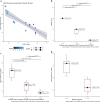Relationship Between Vitamin D Status and Brain Perfusion in Neuropsychiatric Lupus
- PMID: 35607635
- PMCID: PMC9123148
- DOI: 10.1007/s13139-022-00741-x
Relationship Between Vitamin D Status and Brain Perfusion in Neuropsychiatric Lupus
Abstract
Purpose: Neuropsychiatric manifestation of lupus (NPSLE) is related with vitamin D (vit-D) deficiency which is possibly amenable to supplementation. This study was done to explore link of serum vit-D level and clinical mini-mental state examination (MMSE) with brain perfusion SPECT (BS) in patients with NPSLE.
Methods: Patients who underwent BS with the diagnosis of NPSLE and had serum levels of vit-D and MMSE within a span of 1 month were retrospectively included. The BS DICOM data were used to generate 3D surface images of brain for visual identification of regional hypoperfusion, and the z-scores from eZIS software and then to perform voxel-based regression analysis in order to explore association between serum vit-D level and cerebral perfusion deficit using SPM8. Distribution of serum vit-D level was checked across MMSE and BS z-score using R.
Results: A total 19 patients with means ± SD age of 28.4 ± 9.2 years, having mean levels of serum vit-D of 18.7 ± 9.8 ng/ml and mean MMSE scores 24.2 ± 1.6, had undergone BS. The eZIS-derived z-score fall in the category of normal in six (31.6%), mild perfusion deficit (PD) in 10 (52.6%) and moderate PD in three (15.8%) with the means ± SD of z-score being 0.52 ± 0.2, 1.72 ± 0.2, and 2.33 ± 0.2. Voxel-based analysis revealed significant positive correlation between vit-D level and hypoperfusion in brain regions related to cognitive function (p<0.05). Serum vit-D levels were significantly lower in NPSLE patients with lower MMSE scores as well as in higher eZIS z-score (p < 0.01).
Conclusions: Our results may support the utility of vit-D supplementation in NPSLE and applicability of BS as a clinical adjunct for monitoring response to vit-D supplementation.
Keywords: Brain; Cognitive function; Neuropsychiatric systemic lupus erythematosus; SPECT; Statistical parametric mapping; Vitamin D deficiency; Voxel-based analysis.
© The Author(s), under exclusive licence to Korean Society of Nuclear Medicine 2022.
Conflict of interest statement
Competing InterestsNasreen Sultana, Azmal Kabir Sarker, Hiroshi Matsuda, Md. Amimul Ihsan, Syed Atiqul Haq, Md. Saidul Arefin, and Sheikh Nazrul Islam declare no conflict of interest.
Figures



References
LinkOut - more resources
Full Text Sources
